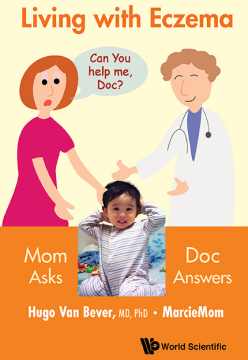
Additional Information
Book Details
Abstract
This book is a unique collaboration between a mother of a child with atopic dermatitis (AD) and the doctor who is treating the child — it offers practical information on AD, recent research findings and tackles many aspects of living with eczema that patients have through the conversation between the mother and doctor. Therefore, this book is an up-to-date comprehensive resource for people suffering from AD, parents of children who suffer from AD and practitioners who treat AD. In brief, for everybody interested in AD.This book's importance in atopic dermatitis lies not only in its up-to-date comprehensive information, but also in that it offers an avenue where patients can have their questions answered by a doctor via the Q&A between the mother and the doctor. Patients may not be able to ask all the questions on their mind in a consultation, and this book totaling over 100 questions will have many of them answered.
Table of Contents
| Section Title | Page | Action | Price |
|---|---|---|---|
| Contents | xi | ||
| Foreword | vii | ||
| Foreword | ix | ||
| Introduction | xiii | ||
| Aim of the Book | xiv | ||
| Part 1 Learning about Eczema | 1 | ||
| Chapter 1 Eczema Basics | 3 | ||
| Definition | 3 | ||
| The most Common Types of Eczema (Overlap Exists) | 3 | ||
| Other Types of Eczema | 3 | ||
| Seborrhoeic Eczema | 4 | ||
| Contact Eczema or Contact Dermatitis | 5 | ||
| Factors inducing contact dermatitis in children | 7 | ||
| Epidemiology, Symptoms and Prognosis of AD | 7 | ||
| Epidemiology | 7 | ||
| Symptoms | 7 | ||
| Infants | 8 | ||
| Older children (age 2 to 11 years) | 9 | ||
| Adolescents and adults | 10 | ||
| Prognosis | 12 | ||
| Chapter 2 Normal Skin versus Eczema Skin | 17 | ||
| Introduction | 17 | ||
| The Structure of Normal Skin in Children and Adults | 17 | ||
| Epidermis | 17 | ||
| Keratinocytes | 18 | ||
| Melanocytes | 19 | ||
| Langerhans cells | 19 | ||
| Dermis | 20 | ||
| Subcutis | 21 | ||
| Functions of the Skin | 21 | ||
| The Normal Skin at Birth | 24 | ||
| The Role of Skin Microbiota in Health and in Eczema | 25 | ||
| The Skin in Children with Eczema | 27 | ||
| Other Mechanisms Involved and a Hypothetical Model of Eczema | 28 | ||
| Conclusion: A Hypothetical Model of Onset of AD in Early Infancy | 29 | ||
| Part 2 Living with Eczema | 37 | ||
| Chapter 3 Eczema Diagnosis | 39 | ||
| Common Diagnosis Methods | 39 | ||
| Family History | 39 | ||
| Past Medical History | 40 | ||
| Examination of the Skin | 40 | ||
| Differential Diagnosis of AD | 42 | ||
| Scabies | 42 | ||
| Gianotti-Crosti syndrome | 43 | ||
| Psoriasis | 44 | ||
| Prurigo Nodularis | 44 | ||
| Skin infections | 45 | ||
| Immune disorders | 45 | ||
| Part 3 Eczema and Beyond | 145 | ||
| Chapter 8 The Pathophysiology of Atopic Dermatitis | 147 | ||
| Hypothetical Model of AD | 148 | ||
| AD in Early Infancy (Age 1–3 Months) — The Onset of AD | 148 | ||
| AD in Early Childhood (Older Infants Aged 3–12 Months and Preschoolers) | 149 | ||
| AD in Older Children and Adults | 150 | ||
| Chapter 9 Things that Don’t Work | 157 | ||
| Chapter 10 Future Research on Atopic Dermatitis | 165 | ||
| Top Five New Research Findings in AD | 166 | ||
| The Future Approaches and Future Treatments | 166 | ||
| On the diagnosis of AD | 166 | ||
| On the management of AD | 167 | ||
| Prevention of AD: “What Can I Do to Prevent My Newborn Baby from Developing AD or Becoming Allergic?” | 168 | ||
| Chapter 11 Conclusion | 173 | ||
| Appendix A | 175 | ||
| Daily Food Journal | 175 | ||
| Appendix B | 177 | ||
| Checklist to Alternate Caregiver | 177 | ||
| References | 179 | ||
| 1. INTERNET SITES | 179 | ||
| 2. TEXTBOOKS | 180 | ||
| 3. ARTICLES IN MEDICAL JOURNALS | 180 | ||
| 1. Review Articles | 181 | ||
| 2. Epidemiology of Eczema | 181 | ||
| 3. Symptoms of Eczema | 182 | ||
| 4. Contact Dermatitis | 182 | ||
| 5. Eczema in Adults | 182 | ||
| 6. Underlying Mechanisms (Skin Barrier Disorders,Allergy, and Role of Staphylococcus Aureus and Microbiota) | 182 | ||
| 7. Diagnosis–Tests | 183 | ||
| 8. Prevention of Eczema | 183 | ||
| 9. Treatment of Eczema | 184 | ||
| 10. Prognosis and Long-Term Evolution | 185 | ||
| 11. Future Research | 185 | ||
| Index | 187 |
